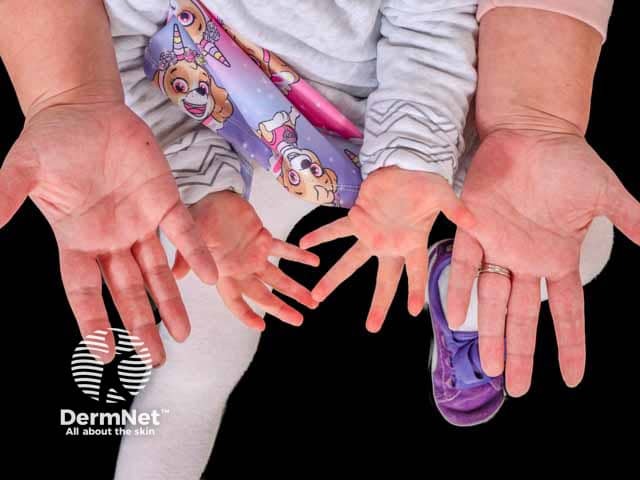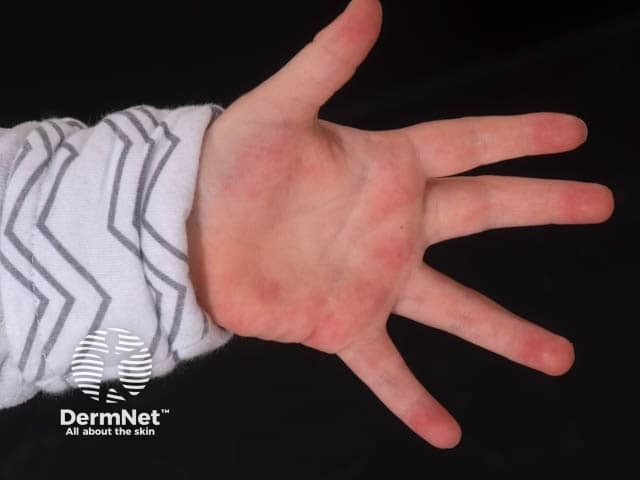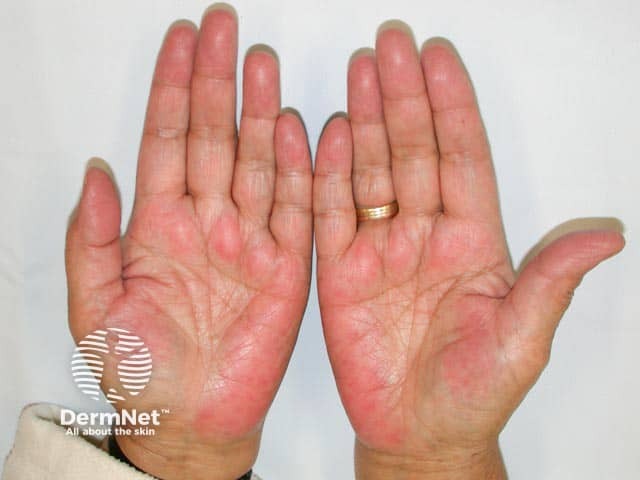Main menu
Common skin conditions

NEWS
Join DermNet PRO
Read more
Quick links
Erythema palmare hereditarium — extra information
Erythema palmare hereditarium
Authors: Dr Caroline Mahon, Paediatric Dermatologist; Dr Kate Alfeld, Senior Medical Registrar, Canterbury District Health Board. Christchurch, New Zealand. Copy edited by Gus Mitchell. November 2021
Introduction
Demographics
Causes
Clinical features
Complications
Diagnosis
Differential diagnoses
Treatment
Outcome
What is erythema palmare hereditarium?
Erythema palmare hereditarium (EPH) is not a disease but an inherited tendency to develop persistent redness of the palms and fingertips. It may also affect the soles of the feet.
Erythema palmare hereditarium is also known as red palms or Lane's disease, and was first described by Dr John E. Lane in 1929. It is a form of primary palmar erythema.

Palmar erythema in mother and daughter

Palmar erythema in daughter

Subtle palmar erythema in mother
Who gets erythema palmare hereditarium?
Erythema palmare hereditarium has only 17 cases described in published medical reports as of 2021. It is, however, probably under-recognised as it does not cause significant symptoms in affected people. Of those who have been reported, the majority were women or girls (11 of 17). Most patients had an affected close family member (first degree relative) who also had EPH.
What causes erythema palmare hereditarium?
Erythema palmare hereditarium is thought to be genetic as the development of palm redness occurs at birth or in early infancy and persists throughout life; a parent is often also affected. To date, no specific genetic abnormality has been identified. Variable inheritance patterns have been described including an autosomal dominant, pseudodominant, and recessive transmission. Sporadic cases have been reported.
What are the clinical features of erythema palmare hereditarium?
- Redness typically spares the central palms and is more prominent in the:
- Heel of the palm (hypothenar eminence)
- Base of the thumb (thenar eminence)
- Fingertips.
- Predominant dermoscopic finding is a pattern of branching blood vessels on a red, structureless background.
- Future studies using dermoscopy may be required to understand its use in EPH diagnosis.
How do clinical features vary in differing types of skin?
Given the limited publication on EPH, there is no current literature describing variation in presentation in different skin types.
What are the complications of erythema palmare hereditarium?
Erythema palmare hereditarium is a benign condition with no known complications. However, some people who are affected are self-conscious of the redness of their hands.
How is erythema palmare hereditarium diagnosed?
Erythema palmare hereditarium can be diagnosed if:
- There is a positive family history
- Onset is shortly after birth or during early childhood
- Other illnesses that cause palmar erythema have been excluded.
Biopsy is not considered essential in the diagnosis but previous reports have shown dilated vessels in the entire dermis with no inflammatory infiltrate.
What is the differential diagnosis for erythema palmare hereditarium?
- Other causes of palmar erythema such as pregnancy, liver dysfunction, or a drug-induced reaction.
- In children, common causes of palmar erythema other than EPH include Kawasaki disease, Wilson disease, and poisoning (mercury).
What is the treatment for erythema palmare hereditarium?
Erythema palmare hereditarium has no known treatment.
What is the outcome for erythema palmare hereditarium?
The skin changes seen in EPH can change with different environments, however it does not progress or involve other organs.
Bibliography
- Lane JE. Erythema palmare hereditary (red palms) Arch Derm Syphilol. 1929;20(4):445–8. doi:10.1001/archderm.1929.01440040017003. Journal
- Gurioli C, Patrizi A, Lambertini M, Neri I. Lane's Disease (Erythema Palmare Hereditarium): A Report of Five Cases and a Review of the Literature. Pediatr Dermatol. 2017;34(5):590-594. doi:10.1111/pde.13211. Journal
- Özer EC, Demir G, Aktas M, Salman A. A case series and literature review of erythema palmare hereditarium (Lane's disease). Indian J Dermatol Venereol Leprol. 2021 Jan-Feb;87(1):64–6. Journal
- Langenauer J. Erythema palmare hereditarium (‘Red Palms’, ‘Lane’s Disease’). Case Rep Dermatol 2014;6:245–7. Journal
- Kluger N, Guillot B. Erythema palmare hereditarium (Lane's red palms): a forgotten entity?. J Am Acad Dermatol. 2010;63(2):e46. doi:10.1016/j.jaad.2009.05.033. Journal
On DermNet
Other websites
- Erythema palmare hereditary — Rare Disease InfoHub
Books about skin diseases
